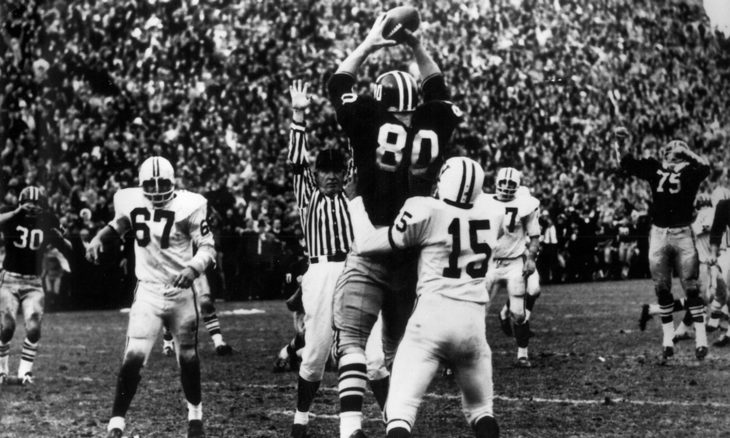Movie Review: Harvard Beats Yale, 29-29
Documentary (2008)
Viewed on: February 20, 2010

Pete Varney of Harvard (#80) catches the two-point conversion to tie Yale at the end of the game. (Photo courtesy of Harvard Athletic Communications)
“He threw it to me and the ball looked like a watermelon coming at me. I mean it looked huge, you know? It was that moment where all of those years of playing football and playing catch in the backyard with my father, I mean, there it was, right? That big football coming right at you.”
That quote comes near the climax of Harvard Beats Yale 29-29, which is a charming shoestring tackle of a film, a gritty two-point conversion of a documentary, or whatever other football metaphor you prefer. It’s done on an obviously low, low, low budget, with the most basic locked-down camera and the simplest of lighting… and it works!
The topic is the legendary football game played by Harvard and Yale in 1968. It was the last game of the season. Both teams were unbeaten, but Yale, the traditional powerhouse, was supposed to win easily. Their quarterback, Brian Dowling, literally had won every game he’d started since junior high.
And in fact, Yale was up 22-0 early in the second quarter. But in the second half, things got weird. The title of the movie is taken from the triumphant headline that appeared the next day in the Harvard student newspaper, the Crimson: HARVARD BEATS YALE 29-29.
The film couldn’t be simpler: interviews with players from both sides, conducted in ones and twos in kitchens and living rooms and cluttered offices, intercut with footage from the game as it was broadcast on TV. That footage adds a terrific sense of time and place, with the imperfect grass and the tall striped socks and fans crammed in at the edges, and the scrawny players mixed in with a few “giants” of 240 pounds or so. To show you how small players were in those days: actor Tommy Lee Jones was an offensive lineman for Harvard.
Jones is interviewed here, along with Dowling and many others. This being Harvard-Yale, there are all kinds of weird brushes with fame: Dowling was the model for B.D., the character who never removed his football helmet in the comic strip Doonesbury. (Garry Trudeau was going to Yale at the time, and his campus cartoons already featured B.D.) A Yale linebacker, Mike Bouscaren, is said to be the maybe-inspiration for Mike Doonesbury himself.
One of the Yale players had roomed with George W. Bush, another brought Meryl Streep to a team function. (Streep was at Vassar — Yale was still all-male at the time.) Tommy Lee Jones was rooming with Al Gore at Harvard, and seems irritated to be asked about it. (In fact, Jones is the surprising clinker of the whole movie — he seems grouchy, weary, or like he just doesn’t want to be seen taking anything seriously.)
Despite all the later-to-be-famous angles, the meat of the movie is just a bunch of old ballplayers talking about the game and the era and how each team pulled together in the crazy social environment of 1968. The best stuff is the low-key stuff, like the interviews with Frank Champi, Harvard’s second-string quarterback, a lumpy local kid who preferred throwing the javelin and seemed to be on the football team as an afterthought. He gets tossed into the game in the second quarter, with Harvard down 22-0; his teammates have funny things to say about trying to decipher his ripe Boston accent in the huddle.
As the film plays out, the pale November sunlight fades into misty gloaming in Harvard Stadium, while the memories and the emotions of the players get more intense. It’s a pleasure to ride along.
The glow at the end, in fact, reminded me a lot of the nostalgic glow of the F. Scott Fitzgerald football story The Bowl — in which, coincidentally, Princeton ties Yale. (The way college football has developed, the Harvard-Yale game of ’68 must have been about the last time you could compare it to anything written by Fitzgerald.)
Kevin Rafferty — listed as the film’s director, producer, cinematographer and editor — was an undergrad at Harvard at the time of the game. He’s actually a lot more experienced than the crude look of the film might indicate — he directed The Atomic Cafe (1982), was a mentor to Michael Moore on Roger and Me (1989), and ran a camera for the Bill Clinton documentary The War Room (1993). So he knows what he’s doing, even if the camerawork and sound don’t always look like it. And he knows how to interview.
One frustrating aspect of the movie is that the famous headline from the Crimson is never shown and never discussed. Rafferty even calls it “One of the most famous sports headlines of all time” in this interview on Fresh Air, but the film never wonders who wrote the headline or gives them credit. Too bad — it would be good to know. As thrilling as the game was, it surely wouldn’t be as famous without that headline as its eternal shorthand.
(Curiously, a search of the Harvard Crimson online archives shows no evidence of that original story or the headline — though the archives have many subsequent references to the game.)
Still, that’s a nitpick. This is not a glossy film, but it’s an enjoyable one. I give it 8 touchdowns out of a possible 11.
For more background on the game, here’s the story Sports Illustrated ran in 1968. (With Tommy Lee Jones described as “Tom Jones, a 200-pound actor who plays left guard.”)
And if you like a thoughtful and juicy football story, read Fitzgerald’s The Bowl.
